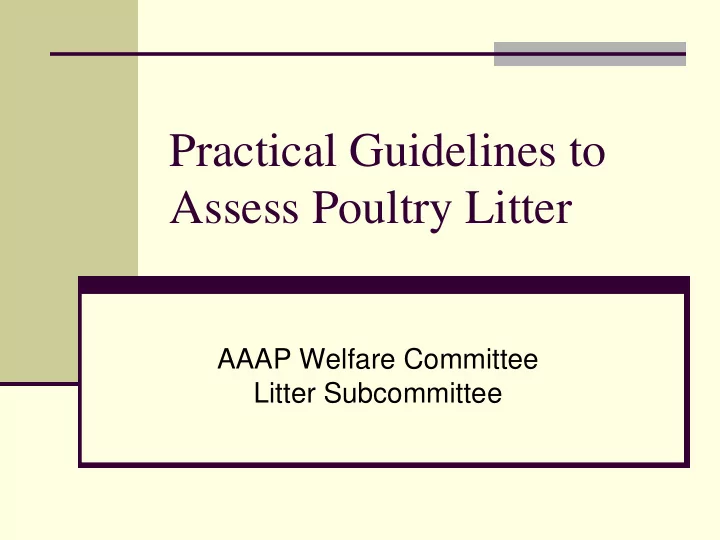

Practical Guidelines to Assess Poultry Litter AAAP Welfare Committee Litter Subcommittee
Mission As proper litter management can impact poultry health and comfort in a number of ways, it is directly involved with welfare. Thus the goal of this committee is: To provide practical guidance to welfare auditors on how best to assess litter conditions in the field from a welfare perspective
Methods to Accomplish Mission Develop a written litter assessment model outlining litter quality factors of importance if an objective measurement is required Provide digital images and comments where applicable to help illustrate important criteria outlined in the litter assessment model Update any new, practical methodologies which could be used in the field to help assess litter
Litter Management Assessment Model AAAP – PAACO Litter Management Assessment Model AUDIT CRITERIA - Litter Quality Factors: Points Caked litter present? Not evident 100 Donuts under waterline nipples 90 Strip under waterlines < 12 inches wide 80 Strip under waterlines > 12 inches wide 70 Along sidewall footings only 60 End doors and corners only 50 In front of “Cool Cell” pads only 50 Sidewall to outermost nipple drinker line 40 Sidewall to centermost nipple drinker line 20 Wall to wall caked litter 0 Litter Moisture – estimated Dry, friable, free flowing on compression 100 Extremely dry/dusty and very fine particles 80 “Sticky” on hand when compressed, clod crumbles 80 Forms “clod” when compressed 50 Very wet on compression? 0 Bedding/Litter Quality Uniform size bedding particles 100 Some larger wood chips or sharp particles 75 Some “chucks” of cake 75 Extensive large and sharp bedding particles 25 Extensive residual cake from previous flock 25 Ammonia (at time of inspection) <25 ppm 100 25-50 ppm* 50 50-75 ppm* 25 75 -100 ppm* 0 *Deduct 25 additional points if birds <2 wks old.
Caked Litter Present? Not evident 100% Donuts under waterlines 90% Strip < 12 inches / > 12 inches 80 / 70 Along sidewalls 60% End doors and corners 50% Front of Cool Cells 50% Sidewall to outer waterline / inner line 40 / 20 Wall – to-wall cake -0-
Important Field Realities You will often find a small amount of caking under the water and feeder lines These are the primary areas that birds will be stimulated to excrete feces as they eat and drink, which adds moisture to the litter under these locations This is not necessarily indicative of a problem Take the rest of the litter area between the feeder and drinker lines into consideration
Caking Under the Drinkers
Caking in Used Litter Around Feeders
Old Litter Without Caking
Significant Caking in Curtain Sided, Turkey House
Donuts
Caking Under Nipple Drinkers
Caked Litter Management - FYI Most companies will remove old cake crust out of the poultry house or till it into the litter between flocks This is a common, acceptable practice for built-up litter The degree of caking will be impacted by a number of other factors such as litter depth, litter age, stocking density, and type of housing/ ventilation
Before Removing Cake
After Removing Cake – Old Litter
Management Factors Impacting Litter Ventilation has a major impact, as it is the primary way to remove moisture from the poultry house Proper temperature control, insulation, and mixing of incoming air will influence the degree of caking along the sidewalls/fans, especially during cooler weather Water line maintenance and management also play a big factor
Litter Moisture Management Height Adjustment Drinker Nipple Maintenance “Donuts”
Corner Caking
Cake in the Corner and Along Wall
Caking Around Fans, Cool Cells
Sidewall Caking
Sidewalls, Endwalls
Litter Moisture Dry, friable, free-flowing 100 Dry, dusty, very fine texture 80 Sticky on compression, crumbles 80 Clod on compression 50 Wet -0-
Litter Moisture – Practical Estimate Too damp About right
Devices Are Available to Measure Litter Moisture
Bedding / Litter Quality Uniform size particles 100 Large wood chips 75 Chunks of cake 75 Extensive large / sharp particles 25 Extensive residual cake 25
Good House Litter Conditions
Good, New Litter
New Poult Set-Up with Rings
Old Litter – Good Condition
Undesirable Bedding Materials
Poor Quality Bedding – Large Pieces
Types of Material Used for Litter Various materials have been used for litter Pine shavings/sawdust, hardwood shavings, rice hulls, oat hulls, sand, newspaper pellets, and possibly other materials Wood shavings or rice/oat hulls are the primary materials used by the poultry industry
Pinewood Shavings
Pinewood Shavings
Sawdust
Oat Hulls
Litter Thickness – Will Vary from Company to Company
Ammonia < 25 ppm 100 25-50 ppm 50 51-75 ppm 25 75 -100 ppm -0- Deduct 25 additional points if birds less than 2 weeks of age
Measure Ammonia Objectively
Ammonia – at Bird level
Committee Members H.L Goodwin, PhD – University of Arkansas Jesse Grimes, PhD – NCSU Joe Hess – PhD, Auburn University Theresia Lavergne, PhD – LSU Bud Malone, MS – University of Delaware Ken Opengart, DVM, PhD – Keystone Randy Chick, DVM – USDA (Original Chair) Tim Cummings, DVM – Concluding Chair Mississippi State University
Recommend
More recommend